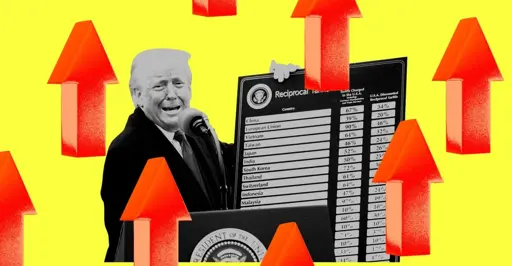In a statement from China’s Ministry of Finance, which we’ve translated using Google, the country says that any further tariffs from the US side would “no longer make economic sense,” and that the US “will become a joke in the history of the world economy.”
China says that at the new tariff rate of 125 percent there is no longer any “market acceptance for US goods exported to China,” so there’s no sense in raising tariffs further. “If the US continues to play the tariff numbers game, China will ignore it,” the statement says.
China isn’t ruling out other forms of retaliation, however, ending the statement with a warning: “If the US insists on continuing to substantially infringe on China’s interests, China will resolutely counterattack and fight to the end.” Yesterday the country announced it was reducing the number of Hollywood films it would permit to release, and over the last week it has also restricted import and export rights for a number of US companies.



Look at this graph:
So… draw your own conclusions.
I initially wrote a long analysis, but then I figured that these numbers are quite big to fuck around with. We’ll find out soon enough.
It always makues meh lauff
How did our SPYs get so red?
COVID knocked all global trade in that period.
Yes sure.
Now, if you look at the change from the beginning of Trump’s first term where the tariffs were increased by 10% points (from 10% to 20%) and to the end of Biden’s term in which Trump’s tariffs were maintained, the imports dropped by 100 billion - regardless of COVID.
That could be a good thing or a bad thing depending on what you want to talk about.
But… now Trump increases the tariffs by an additional 114% points. (From 20% to 134%)
Assuming there is a correlation between tariffs and imports, which is the very point of doing it according to Trump, that would mean that imports would have to drop 1140 billion. This is obviously not possible from a 400 billion import, so it’s essentially putting a full stop to all trades with China.
Is that a good thing or a bad thing? Well. It’s great that USA is not paying China, but… where does USA get stuff from then? 400 billion dollars worth of stuff not being available in USA will definitely cause all kinds of issues.
Didn’t a lot of the trade with China just end up being rerouted through other countries. Does this graph take that into account.
The graph doesn’t even make clear if it’s using inflation adjusted USD (which is the only fair way to compare trade numbers over a period of decades) or just nominal annualized USD (where 1 USD represents quite a different amount of worth in 1990 than it does in 2025).
That is not a positive indication on the competence of the people doing it, and it seems unlikely that they fucked up something as basic as this whilst at the same time being professional enough to dig up and include information on estimated rerouted trade flows (which would be a lot more work to obtain).
Mind you, inflation adjusted USD wouldn’t really change the trend, but it would change the steepness of the growth over the years, plus it’s just the proper way to represent such data.
This graph probably not, but it’s one of the reasons why south east asian countries like Vietnam also got slapped with hefty tariffs. Not to mention the nefarious Penguin Kingdom.
Looks like a reduction in trade roughly on par with 2008 in absolute terms but maybe only 2/3 as much in relative terms?
I think that is optimistic. Here’s another graph:
Graph ends before 2nd Trump term.